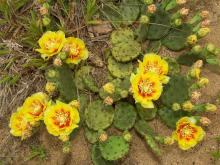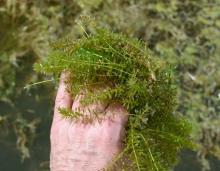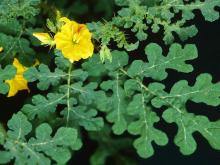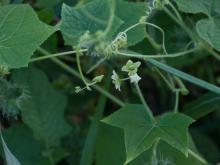Wildflowers, Grasses and Other Nonwoody Plants
Media

Species Types
Scientific Name
Galium aparine
Description
The tiny white flowers of this native plant are not very memorable, but the curious, sticky-feeling whorls of narrow leaves and lightweight, 4-sided stems make cleavers unique. And then there’s the tiny, round, “Velcro” covered balls of the seeds, which “stick tight” to your socks!
Media

Species Types
Scientific Name
Opuntia humifusa (formerly O. compressa)
Description
Cacti make us think of the desert southwest, but there is at least one species native to Missouri. This prickly pear grows in glades, sand prairies, rocky open hillsides, and other dry, sun-soaked areas.
Media

Species Types
Scientific Name
Hydrilla verticillata
Description
Hydrilla is probably the worst submersed aquatic weed in America. It harms aquatic communities in small ponds, lakes, and rivers. It hurts our economy by hindering fishing and other recreational uses in large reservoirs. Learn about it and prevent its spread.
Media

Species Types
Scientific Name
Yucca smalliana, Y. glauca, and Y. arkansana
Description
Three species of yucca grow wild in Missouri. Spanish bayonet was introduced from the Southwest and has escaped from cultivation, but our two soapweeds are native.
Media

Species Types
Scientific Name
Solanum rostratum
Description
A spiny annual with bright yellow flowers and dandelion-like leaves, buffalo bur is an introduced member of the nightshade family.
Media

Species Types
Scientific Name
Datura stramonium
Description
Pretty but poisonous, jimsonweed has white goblet-shaped flowers that open around midnight. This native of tropical America was introduced nearly throughout the United States and thrives in disturbed soils.
Media

Species Types
Scientific Name
Solanum carolinense
Description
Horse nettle is a native perennial with spiny stems and leaves, white to purplish flowers, and toxic fruits that look like tiny yellow tomatoes. It does well in disturbed habitats, and many people consider it a weed.
Media

Species Types
Scientific Name
Sicyos angulatus
Description
Bur cucumber is a nonwoody, native, annual vine common in low, moist soils. It can spread across an area 20 feet wide, covering the ground and nearby shrubs. Note its lobed, gourd-family leaves, curly green tendrils, clusters of prickly, green, oval fruits, and 5-lobed, cream-colored flowers.
See Also
About Wildflowers, Grasses and Other Nonwoody Plants in Missouri
A very simple way of thinking about the green world is to divide the vascular plants into two groups: woody and nonwoody (or herbaceous). But this is an artificial division; many plant families include some species that are woody and some that are not. The diversity of nonwoody vascular plants is staggering! Think of all the ferns, grasses, sedges, lilies, peas, sunflowers, nightshades, milkweeds, mustards, mints, and mallows — weeds and wildflowers — and many more!





















